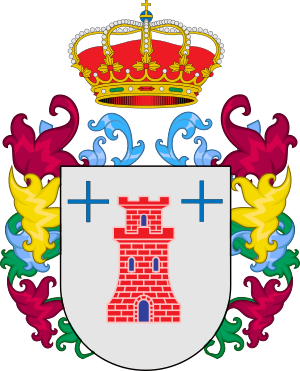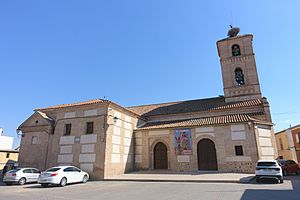El Carpio de Tajo facts for kids
El Carpio de Tajo is a charming village located in the province of Toledo. It is part of the autonomous community of Castile-La Mancha in Spain. This small town sits near the Tagus River, which is one of the longest rivers in the Iberian Peninsula. El Carpio de Tajo is known for its quiet, traditional Spanish atmosphere and its rich history.
Contents
What is El Carpio de Tajo?
El Carpio de Tajo is a municipality, which is like a local government area, in central Spain. It's a place where people live, work, and go to school. The village is surrounded by beautiful natural landscapes, including fields and forests. It offers a glimpse into traditional Spanish village life.
Where is El Carpio de Tajo Located?
This village is found in the western part of the province of Toledo. It's about 50 kilometers (31 miles) west of the city of Toledo, which is the capital of the province. The Tagus River flows nearby, influencing the local environment and history. Its location in Castile-La Mancha means it shares the region's unique culture and traditions.
A Look at Its History
The history of El Carpio de Tajo dates back many centuries. Like many places in Spain, it has seen different cultures and civilizations. The area was likely settled by ancient peoples, and later by Romans and Moors. During the Reconquista, when Christian kingdoms retook Spain, the village became part of the Kingdom of Castile. Over time, it grew into the peaceful community it is today.
Important Historical Moments
In the Middle Ages, the village played a role in the defense of the Tagus River area. Its strategic location meant it was important for controlling routes. Later, during the modern era, life in El Carpio de Tajo revolved around farming and local crafts. The village has preserved many of its historic buildings, showing its long past.
What Can You See in El Carpio de Tajo?
Even though it's a small village, El Carpio de Tajo has some interesting places to visit. These sites tell stories about its past and its people. They are great examples of local architecture and culture.
The Church of San Miguel Arcángel
One of the most important buildings is the
Church of San Miguel Arcángel (Saint Michael the Archangel). This church is a central part of the village. It has been built and rebuilt over centuries, showing different architectural styles. It's a place of worship and a historical landmark. The church's bell tower is a notable feature, visible from many parts of the village.
Traditional Architecture
Walking through El Carpio de Tajo, you will see many traditional Spanish houses. These homes often have white walls and red tile roofs. They are built to stay cool in the summer and warm in the winter. The narrow streets and small squares add to the village's charm. It feels like stepping back in time.
Life and Culture in the Village
Life in El Carpio de Tajo is generally calm and community-focused. The village celebrates traditional Spanish festivals and holidays. These events are important for bringing people together.
Local Festivals and Traditions
Like many Spanish villages, El Carpio de Tajo has its own unique festivals. These often include religious processions, music, dancing, and traditional food. They are a chance for everyone to celebrate their heritage. These festivals are a big part of the local culture and community spirit.
Daily Life and Economy
The economy of El Carpio de Tajo has historically been based on agriculture. Farmers grow crops like cereals and olives. Some people also work in local businesses or commute to nearby towns. The village offers a quiet lifestyle, away from the hustle and bustle of big cities. It's a place where community ties are strong.
How is El Carpio de Tajo Governed?
El Carpio de Tajo is governed by a local council, called an Ayuntamiento. This council is made up of a mayor and several council members. They are elected by the people of the village.
The Role of the Local Council
The local council is responsible for managing the village's services. This includes things like maintaining streets, collecting trash, and organizing local events. The mayor is the head of the council and represents the village. Their job is to make decisions that benefit the community. This system helps ensure that the village's needs are met.
See also
 In Spanish: El Carpio de Tajo para niños
In Spanish: El Carpio de Tajo para niños



